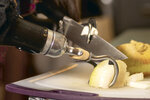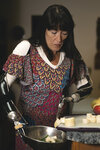

If you see Mary McGriff shopping at Key Center Food Market and ask what happened to her hands, she’ll tell you more than you probably wanted to know.
“I got my arms chopped off by a serial killer.”
The poignant answer catches people off-guard, and most ask if she’s joking.
No. She’s not.
But after that fateful night in Sept. 1978, she likely can use her “new hands” as well as most people use theirs.
Nearly 45 years ago in Berkeley, California, the former Mary Vincent, 15-years-old at the time, accepted a ride from an older man while she was hitchhiking to visit her grandpa near Los Angeles. What followed was a night of rape and torture that ended with her attacker, 51-year-old Lawrence Singleton, chopping off both her arms below the elbow with a butcher knife and leaving her for dead down a 30-foot ravine somewhere outside of Modesto.
Incredibly, she was able to crawl out and hike three miles naked and covered in blood to find help. Her attacker was caught nearly two weeks later thanks to her account, and sentenced to 14 years in prison. He was released for good behavior after only serving eight.
Singleton allegedly killed more than a dozen women in his lifetime, but the only one on his record is the 1997 murder of a Florida woman when he lived in Tampa. McGriff'’s testimony against Singleton, along with her following advocacy and legislative work against rapists and child molesters, is said to have helped others from suffering a similar fate as her.
McGriff recovered in the hospital for a month after the attack and was quickly fitted with prosthetic arms. Technology being what it was in the 1970s, her prosthetics weren’t anything fancy, but it was enough to make a statement when she pointed at her attacker during his trial less than six months later.
Her new arms were functional, but not too practical. What from faraway look like hooks are actually curved metal pincers, each working like oversized tweezers. McGriff was limited to just moving them up and down. As an active teenager with tons of hobbies, her hands were her life. She didn’t want the lack of technology standing in her way of doing what she loved to do. She needed her hands to rotate and be flexible. So she took it upon herself to make improvements to her prosthetics.
“I come from a family of tinkerers,” McGriff said. She kept going back to the prosthetic place and bringing items with her that she found around the house.
The mechanism from an old slot machine that makes the lever go up and down helps give her the flexibility she needs. She used a disk from the bottom of the dishwasher that allows her hands to rotate. Her arms also have parts from a bike and a stereo.
“And see how I can put it in lock mode to keep it from moving? That’s from clicking a ballpoint pen.”
It’s that type of ingenuity that’s helped give a double-amputee as normal a life as possible. This was a teenager, remember.
What she uses as her arms today is pretty much the same as it was more than 40 years ago.
She said they don’t look like what someone would expect a prosthetic arm to look like in the year 2023, but she wouldn’t change it.
Her design is so unique that prosthetic companies can work with McGriff to make fixes and changes, but they can’t replicate it until she patents the product. That’s something she’s working toward but said a patent costs more than $25,000.
“They’ll never make a prosthetic device that can do more than mine can,” she said. “I love what they’ve done with technology. They have prosthetic arms that look like real arms and hands with fingers that move, but you can’t really lift any weight and you’d look like a Barbie doll.”
McGriff draws, cooks, gardens, drives, does her own makeup and hair, and carries groceries. She’s a skilled pool player and even threw out the first pitch at a San Francisco Giants game in 1999.
Two things she doesn’t do well with: cell phones and computers. “I have so much metal in me and on me. I’ve shut down whole computer systems.”
But other than that, “Anything you can do, I can do,” she said. “I can probably do a lot of things with my hands you can’t do with yours.”
And when people ask her how she takes a shower or uses the bathroom, she takes the opportunity to give a similar snarky response as when she’s offered a helping hand:
“I use soap and water in the shower, and I use toilet paper in the bathroom. Why, how do you do it?”
In the final part of this three-part series, Mary McGriff describes how she turned her darkest days of depression into works of art. She’s sold thousands of drawings and paintings created with her prosthetic arms.
UNDERWRITTEN BY THE FUND FOR NONPROFIT NEWS (NEWSMATCH) AT THE MIAMI FOUNDATION, THE ANGEL GUILD, ADVERTISERS, DONORS AND PEOPLE WHO SUPPORT INDEPENDENT, NONPROFIT LOCAL NEWS